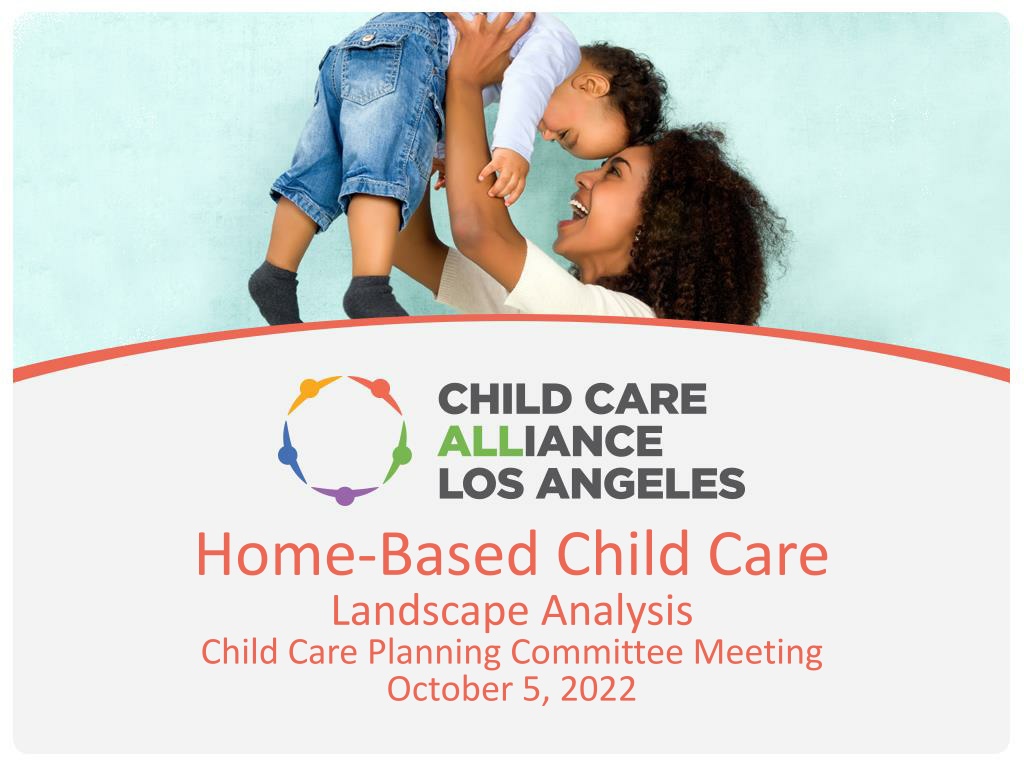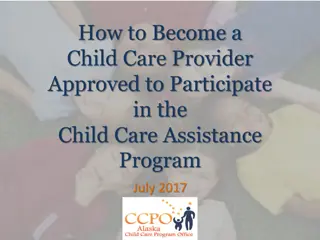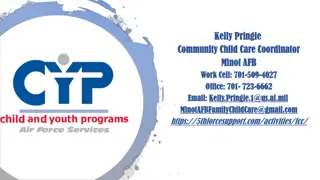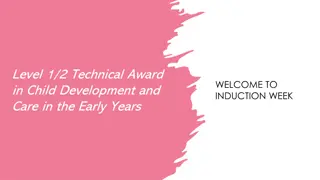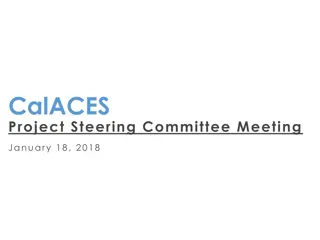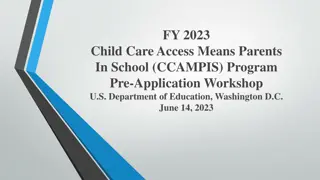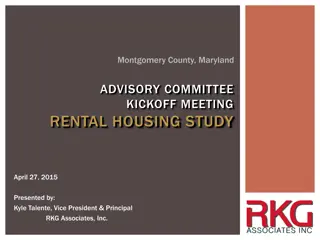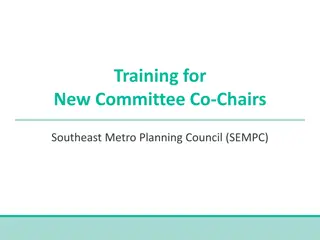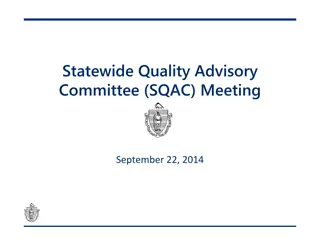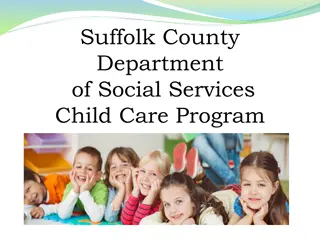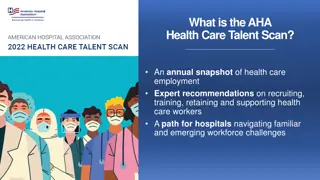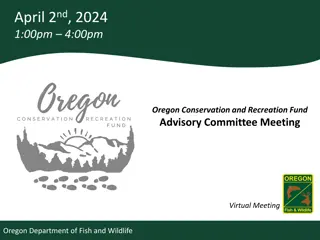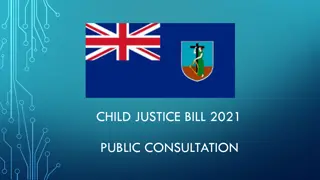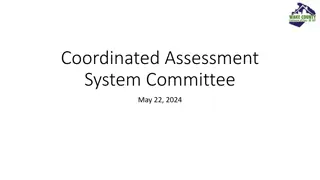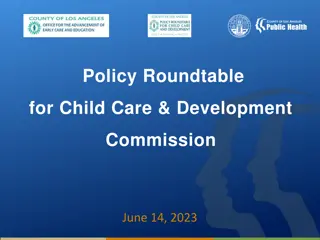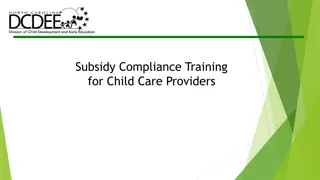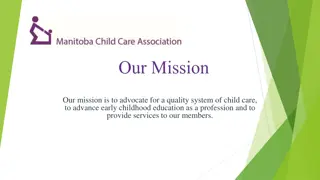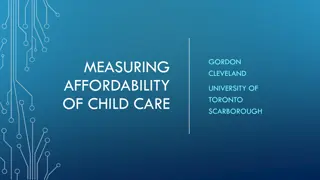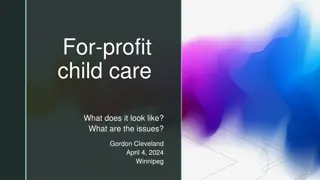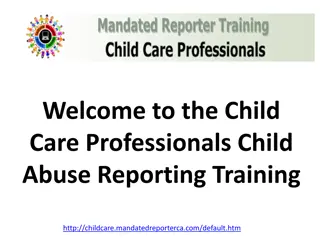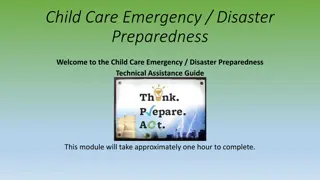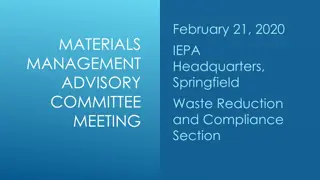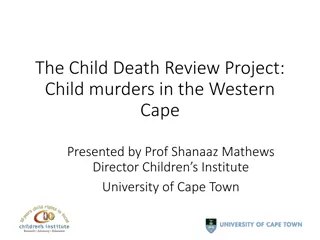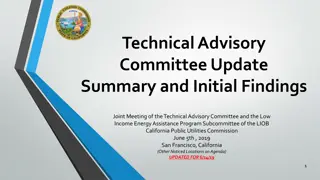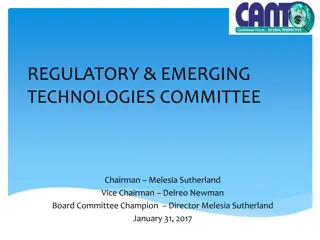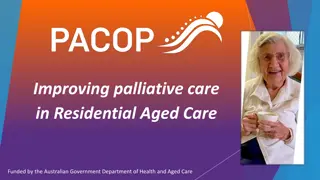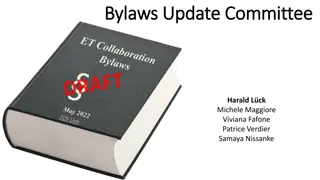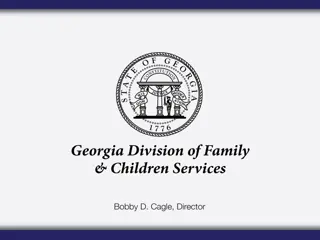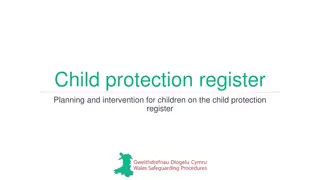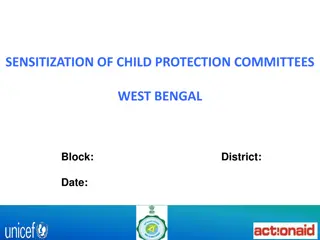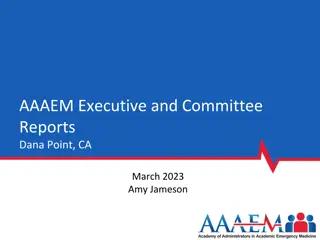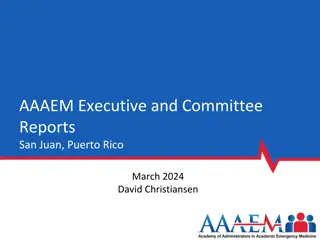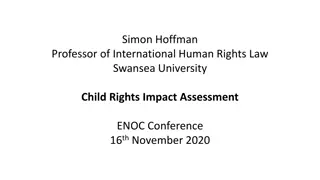Home-Based Child Care Landscape Analysis and Planning Committee Meeting Overview
This document outlines a comprehensive analysis and strategic planning for home-based child care (HBCC) in Los Angeles County. It covers research questions, goals, timelines, and phases of the project aimed at improving the HBCC sector. The preliminary findings, partnership details with Child Care Resource Center (CCRC) and First 5 LA, data collection process, and landscape analysis are highlighted. The research questions delve into the needs, experiences, and perspectives of HBCC providers, children, and families in the context of HBCC services. The ultimate objective is to identify barriers, inform policy recommendations, and create sustainable systems change for the HBCC sector.
Uploaded on Sep 21, 2024 | 0 Views
Download Presentation

Please find below an Image/Link to download the presentation.
The content on the website is provided AS IS for your information and personal use only. It may not be sold, licensed, or shared on other websites without obtaining consent from the author. Download presentation by click this link. If you encounter any issues during the download, it is possible that the publisher has removed the file from their server.
E N D
Presentation Transcript
Home-Based Child Care Landscape Analysis Child Care Planning Committee Meeting October 5, 2022
Home-Based Child Care Landscape Analysis Preliminary Findings In partnership with Child Care Resource Center (CCRC) Research Department 5 Year Strategic Partnership with First 5 LA
Multi-Phase Project Phase 1: Landscape analysis Phase 2: Learn from the landscape analysis Phase 3: Develop pilot projects to support HBCC providers Phase 4: Compile lessons learned from pilots and decide which can be applied at scale Phase 5: With partners, create sustainable systems change and inform policy priorities to enhance the system of HBCC s
Landscape Analysis Goal and Timeline GOAL: Understand the needs of HBCC in Los Angeles County and families who access them. Steps in the process: Data collection design, translation, IRB Approval (consent, surveys, focus groups and key informant interviews in four languages) Data collection (Surveys for family child care providers, family, friends and neighbors and parents, with opt-in language for focus group and interview) Data analysis Sense-making of results Reporting (internal and external) and dissemination
Research Questions Research Question 1: Who are Los Angeles County s home-based child care providers? How do they view their job? Research Question 2: How do Los Angeles County s HBCC providers currently access resources, services, and supports? Research Question 3: What do Los Angeles County s HBCC providers need to become a successful family business? What are their barriers to success? Research Question 4: How has COVID-19 changed the experiences of Los Angeles County s HBCC providers and the children they serve? Research Question 5: Who are the children and families that Los Angeles County s HBCC providers serve? How do they view their HBCC provider? Research Question 6: What policies are needed to build a stronger, more sustainable HBCC sector for the future?
Surveys by Service Planning Area (SPA) FCC FFN Parents Service Planning Area (SPA) (n=775) 75 (10%) 174 (23%) 93 (12%) 63 (8%) 54 (7%) 92 (12%) 173 (22%) 51 (7%) (n=459) 165 (36%) 105 (23%) 23 (5%) 32 (7%) 2 (<1%) 74 (16%) 42 (9%) 15 (3%) 1 (<1%) (n=710) 153 (22%) 283 (40%) 14 (2%) 44 (6%) 27 (4%) 97 (14%) 43 (6%) 37 (5%) 12 (2%) SPA 1: Antelope Valley SPA 2: San Fernando Valley SPA 3: San Gabriel Valley SPA 4: Metro LA SPA 5: West SPA 6: South SPA 7: East SPA 8: South Bay Unknown Total Survey Participants - 775 459 710
Surveys by Race / Ethnicity FCC FFN Parents Race / Ethnicity American Indian or Alaskan Native Asian or Asian American Black or African American Hispanic or Latino Native Hawaiian or Pacific Islander White or Caucasian Multiple ethnicities Not listed Prefer not to answer 5 (1%) 73 (9%) 116 (15%) 438 (57%) 8 (2%) 7 (2%) 11 (2%) 17 (2%) 150 (21%) 393 (55%) 4 (1%) 133 (19%) 35 (5%) 10 (1%) 38 (5%) 130 (28%) 265 (58%) 2 (<1%) 45 (10%) 14 (3%) 1 (<1%) 21 (5%) - 103 (13%) 17 (2%) 13 (2%) 45 (6%)
Surveys by Primary Home Language FCC FFN Parents Primary Home Language English 332 (43%) 314 (68%) 548 (77%) Spanish 330 (43%) 131 (29%) 97 (14%) Armenian 33 (4%) 8 (2%) 43 (6%) Chinese (Mandarin, Cantonese, Other) 38 (5%) 1 (<1%) 2 (<1%) Other 42 (5%) 5 (1%) 20 (3%)
Research Question 1: Who are Los Angeles Countys home-based child care providers? How do they view their job?
Over the years it's been challenging and fulfilling something that I felt that I would have never done but I m so glad and pleased that I did it I helped so many families and children that comes back to visit me and a few that I have their children that I had them years ago at a younger age. I'm very appreciative in the opportunity of serving my community and family home child care based it's been a privilege. And hope many more years to follow and good status. FCC Provider
Survey Participant Profile Characteristic FCC FFN Parents Average age 54 years 49 years 34 years 755 (97%) 419 (91%) 685 (97%) FFNs who are female Never married, not Married, living with Married, living, with a living with a partner Marital Status partner (65%) Some college, no partner (42%) (48%) High school graduate Trade or technical Median education degree or GED school certificate Median household income in 2021 $50,001-$65,000 $15,001-$25,000 $15,001-$25,000
Age Groups Children Served Age Group Served FCC FFN Infants (0-12 months old) 497 (64%) 60 (13%) Toddlers (13-36 months old) 661 (85%) 138 (30%) Preschoolers (3-5 years old, not yet in kindergarten) 679 (88%) 218 (48%) School-age children (5 years and older) 594 (77%) 334 (73%) Serve more than one age group 692 (89%) 215 (47%) Serve at least one child 0-5 years old 741 (96%) 308 (67%)
[The reason I take care of children is because] I have the opportunity to work from home at the same time I help the parents that are in need of care for their children. I try to help as much as possible by making things a little easier to parents such as me picking up the kids from their home or dropping them off or providing cooked meals from me. That way they don t have to worry about putting lunch. I know sometimes it s a little hard especially when there s more than one kid. Relative and Friend FFN Provider
HBCC Providers Main Reasons for Providing Care To help the children's parents, own family members, or friends 75% 14% 7% It is a personal calling or career 49% To have a job that lets provider work from home 8% 15% 1% To help their community 10% FFN FCC 2% To help children 8% 4% To earn money 2% 2% It is a step towards a related career 2% Other 1%
Research Question 2: How do Los Angeles Countys HBCC providers currently access resources, services, and supports?
Participation in Professional Development Activities in the Prior 12 Months FCC Small FCC Large FCC FFN Activity (n=775) (n=234) (n=541) (n=458) 106 (45%) 336 (62%) Workshop, webinar, or training session 442 (57%) 47 (10%) 86 (37%) 248 (46%) Health and safety training 334 (43%) 25 (5%) 21 (9%) 133 (25%) Coaching Enrolled in a course on working with children of different races, ethnicities, and cultures Took course about caring for children at a college or university Participated in a Home Visitation Program None of the above 154 (20%) 12 (3%) 27 (12%) 82 (15%) 109 (14%) 10 (2%) 26 (11%) 65 (12%) 91 (12%) 20 (4%) 9 (4%) 53 (10%) 62 (8%) 4 (1%) 73 (31%) 107 (20%) 180 (23%) 330 (72%)
Participation in Professional Development Programs Number of FCC FCC Small FCC Large Professional Development Program Participating License License (N=775) (n=234) (n=541) 83 (35%) 314 (58%) Family Child Care Home Education Network (FCCHEN) 188 (24%) 28 (12%) 160 (38%) California Early Care and Education Workforce Registry 160 (21%) Emergency Child Care Bridge Program for Foster 28 (12%) 132 (24%) 160 (21%) Children 29 (12%) 131 (24%) Early Head Start Child Care Partnership (EHS-CCP) 141 (18%) 25 (11%) 116 (21%) Quality Start Los Angeles (QSLA) 134 (17%) 16 (7%) 118 (22%) Workforce Pathways Stipend Program 119 (15%) 29 (12%) 90 (17%) Gateways 82 (11%) 16 (7%) 66 (12%) Child Care Initiative Program (CCIP) 66 (9%) 23 (10%) 43 (8%) Quality Start Los Angeles Dual Language Initiative (DLL) 40 (5%) 3 (<1%) 37 (7%) None of the above 276 (36%)
Challenges in Accessing Supportive Services and Professional Development FCC FFN Challenges Lack of time Not offered at a convenient time or location Cost of the services Transportation 384 (50%) 352 (45%) 171 (22%) 37 (5%) 167 (36%) 101 (22%) 96 (21%) 45 (10%) Service or training not offered in own language 100 (13%) 17 (4%) Benefits of participating are not enough Not knowing where to go when need help Technology challenges Nothing prevents them from accessing services or 103 (13%) 118 (15%) 138 (18%) 29 (6%) 72 (16%) 35 (8%) 136 (18%) 137 (30%) professional development Not listed Missing/No response 1 (<1%) 18 (2%) 3 (1%) 10 (2%)
Research Question 3: What do Los Angeles Countys HBCC providers need to become a successful family business? What are their barriers to success?
Challenges Experienced FCC FFN Challenges Not getting paid enough Lack of health, dental, and / or other benefits Sense of burnout Mental health challenges due to stress associated 403 (52%) 305 (39%) 111 (14%) 234 (51%) 58 (13%) 17 (4%) 28 (6%) 136 (18%) with the pandemic Worries about being exposed / infected with the 359 (46%) 111 (24%) COVID-19 virus Managing COVID-related health situations in the 2 (<1%) 73 (16%) program Experiences with racism Not enough flexibility from administrators in what 9 (1%) 4 (1%) 16 (2%) - or how to teach children Too much paperwork None of the above Not listed 80 (10%) 71 (9%) 9 (1%) - 155 (34%) 3 (1%)
Our salary is never going to let us buy our own house. Landlords might not permit us to care for children at their property. We aren't offered any type of health insurance. We as caregivers spend more money on extra food or gasoline. I have to pay my family out of my income to help out when we need help [caring for these children]. It seems that the system wants everyone to be poor. As I have to go out of my way to help take care of a child without a pay. Grandparent FFN Provider
Topics of Interest for Training, Coaching, or Information FCC FFN Topics Child development 331 (43%) 133 (29%) Behavior management and guidance 285 (37%) 155 (34%) Curriculum (FCCs) / Activities for children (FFNs) 274 (35%) 160 (35%) I wish there was some kind of fund to get the children involved in field trips, like the library, the history museum, parks and recreation and things of that nature. Family Relative FFN Provider
I love working with the children I keep. I have injured myself caring for them. I have no health insurance and barely can afford to pay out of pocket. I work sick most time and can't get well. My parents depend on me. I can't take a couple of days off without burdening a parent and risking not getting proper compensation. FFN Provider
Provider Receiving Benefits Benefits FCC 178 (24%) 108 (14%) 88 (12%) 47 (6%) 54 (7%) 98 (13%) 438 (63%) FFN 113 (29%) 68 (18%) 48 (12%) 15 (4%) 9 (2%) 7 (2%) 263 (68%) Health insurance Dental insurance Vision insurance A retirement savings plan (e.g. 401K, 403B) Paid sick time Paid vacation time Do NOT have access to any benefits
Plans for the Future On average, FCC providers plan on taking care of children for 12 more years while FFN providers plan on doing so for 7 more years in their current capacity. 29% of FCCs and 49% of FFNs reported that they plan on taking care of children for 5 more years or less. 24% of FFNs are planning on working towards their family child care license.
Future Plans 15% Retiring 60% 24% Unsatisfied due to low compensation 19% 24% Working towards a license 21% Planning to stay home with own family 6% FFN FCC 8% No longer needed by the family 1% Unsatisfied with working conditions 6% 5% Changing careers / starting school 2% Other 1%
Research Question 4: How has COVID-19 changed the experiences of Los Angeles County s HBCC providers and the children they serve?
The pandemic has put a massive strain in an already difficult underpaid profession. We do this work because we love these children and love giving peace of mind to parents. There are so many moving parts that we juggle with little help and resources. It's been extremely difficult to stay above water, but I love what I do. We need help! It's that simple. FCC Provider
Provider Challenges During Covid Family Child Care Family, Friend, and Neighbor Decrease in child enrollment (54%) Financial hardship in running the program (40%) Difficulty supporting children with distance learning (38%) Challenges with technology (lack of equipment, internet, knowledge) (25%) Not enough access to cleaning or safety supplies (33%) Challenges with technology (lack of equipment, internet, knowledge) (24%) Difficulty in supporting children with distance learning (22%) Financial hardship in taking care of children (19%)
Impact on Parent Employment and Child Care Parents COVID Impact I lost my job, or my spouse/partner lost a job My employer or my spouse s/partner s employer REDUCED my/their work 200 (28%) 178 (25%) hours My employer or my spouse s/partner s employer INCREASED my/their work 44 (6%) hours I started working from home / remote work 90 (13%) I changed the child care arrangements I had from my children 75 (11%) I lost my child care None of the above 34 (5%) 273 (39%)
Financial Impact Parents COVID Impact I am behind on paying my rent/mortgage 209 (30%) I have delayed paying other bills (e.g., utilities, medical bills, credit card) 310 (44%) I am relying on friends or family for financial help I have applied for public assistance (SNAP/EBT, Medicaid, TANF/cash 112 (16%) 268 (38%) assistance) I have a more difficult time buying groceries or am relying on food banks/food 122 (18%) pantries/nonprofits for food assistance I have a harder time paying for health insurance 29 (4%) I have a harder time paying for necessary prescriptions 26 (4%) Other None of the above 3 (<1%) 170 (24%)
Research Question 5: Who are the children and families that Los Angeles County s HBCC providers serve? How do they view their HBCC provider?
Reasons for their Last Child Care Search and How They Sought Care 80% of parents indicated that they last sought child care so that they could work or because they had a change in work schedule The top factors when looking for child care were: location of the child care provider (70%) safety / cleanliness / prevention of illness (66%) flexible hours (early morning, night, or weekend care) (58%) The top reasons for selecting their child care provider were: they were the one they felt most comfortable with (40%) the quality of the care they provided (23%) schedule / hours offered (12%) location (11%) Over half of parents asked friends and family with children when they were looking for child care
Difficulty in Finding the Care of their Choice 40% of parents had difficulty finding their preferred care The challenges were: the cost of care (27%) the quality of care (21%) lack of open slots for new children (19%) location of the provider (17%)
[What I like most about the home-based child care my child is in] is that the provider is my friend and she treats my daughter like her own which makes me feel comfortable. Parent of a toddler in FFN Care [What I like best about my child care] is that it feels like an extension of our family and home. Incredible care taken as if the child were her own. Parent of a toddler and pre-schooler in an FCC program
Level of Satisfaction with their Child Care Provider 95% of Parents reported being satisfied with their child care regardless of type of care. 96 95 95 Percent of Parents 3 3 3 3 2 2 Dissatisfied Neither Satisfied nor Unsatisfied Satisfied FFN FCC All Parents
Next Steps: Analysis of Key Informant Interview (KII) and Focus Groups 29 Family, Friend, and Neighbor (FFN) Key Informant Interviews: Diversity of providers across Los Angeles County oversampling African-American providers 9 Family Child Care (FCC) Provider Focus Groups: 3 in English, 3 in Spanish, 1 in Chinese, and 1 in Armenian 4 Parent Focus Groups: 1 in each language, English, Spanish, Chinese, and Armenian
Next Steps: Sensemaking Sessions Family, Friend, Neighbors (English) Family Child Care Providers (English and Spanish) Parents (English) First 5 LA Provider Advisory Group Resource and Referral Staff Los Angeles Child Care Planning Committee Community Based Organizations and County Agencies Best Start Community Partners
